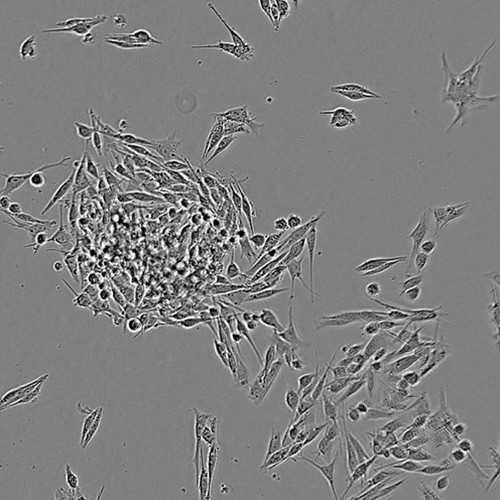Uveal Melanoma Cell Line (MEL202)
The Uveal Melanoma Cell Line (MEL202) was generated from a primary uveal melanoma tumor, and is ideal for the study of uveal melanoma pathogenesis.
Highlights:
- Express melanoma markers gp100, Tyrosinase, and MCSP-1
- Contain activating mutations in GNAQ (Q209L and R210K)
Uveal melanomas arise from the pigment cells (melanocytes) that reside within the uvea giving color to the eye. The tumors are slow-growing primary tumors that develop from normal melanocytes present within either the iris, ciliary body, or chondroid. Uveal melanoma patients display a high rate of metastases, developing almost exclusively in the liver.
From the laboratory of Bruce R. Ksander, PhD, Schepens Eye Research Institute.
 Part of The Investigator's Annexe program.
Part of The Investigator's Annexe program.
The Uveal Melanoma Cell Line (MEL202) was generated from a primary uveal melanoma tumor, and is ideal for the study of uveal melanoma pathogenesis.
Highlights:
- Express melanoma markers gp100, Tyrosinase, and MCSP-1
- Contain activating mutations in GNAQ (Q209L and R210K)
Uveal melanomas arise from the pigment cells (melanocytes) that reside within the uvea giving color to the eye. The tumors are slow-growing primary tumors that develop from normal melanocytes present within either the iris, ciliary body, or chondroid. Uveal melanoma patients display a high rate of metastases, developing almost exclusively in the liver.
From the laboratory of Bruce R. Ksander, PhD, Schepens Eye Research Institute.
 Part of The Investigator's Annexe program.
Part of The Investigator's Annexe program.
Specifications
| Product Type: | Cell Line |
| Name: | MEL202 |
| Cell Type: | Uveal melanoma |
| Accession ID: | CVCL_C301 |
| Morphology: | Epithelial |
| Organism: | Human |
| Source: | Established from a primary eye uveal melanoma |
| Biosafety Level: | BSL1 |
| Growth Conditions: | RPMI 1640 + 2mM Glutamine + 10% Foetal Bovine Serum (FBS) |
| Subculturing: | Split sub-confluent cultures (70-80%) seed new cultures at 1-4x10,000 cells/cm² using 0.25% trypsin or trypsin/EDTA; 5% CO2; 37°C. Saturation density approx 25 x10,000 cells/cm² |
| Storage: | Liquid nitrogen |
| Shipped: | Dry ice |
Data
MEL202 Cell Growth

Provider
From the laboratory of Bruce R. Ksander, PhD, Schepens Eye Research Institute.
References
- Ksander BR, Rubsamen PE, Olsen KR, Cousins SW, Streilein JW. 1991 Studies of tumor-infiltrating lymphocytes from a human choroidal melanoma. Invest Ophthalmol Vis Sci. 32(13):3198-208.
- Chen PW, Murray TG, Salgaller ML, Ksander BR (1997) Expression of MAGE genes in ocular melanoma cell lines. J Immunother 20: 265275.
- de Waard-Siebinga I, Creyghton WM, Kool J, Jager MJ. 1995 Effects of interferon alfa and gamma on human uveal melanoma cells in vitro. Br J Ophthalmol. 79(9):847-55.
- Griewank KG, Yu X, Khalili J, Sozen MM, Stempke-Hale K, Bernatchez C, Wardell S, Bastian BC, Woodman SE. Genetic and molecular characterization of uveal melanoma cell lines. Pigment Cell Melanoma Res. 2012 Mar;25(2):182-7.
- Ma D, Luyten GP, Luider TM, Jager MJ, Niederkorn JY. 1996 Association between NM23-H1 gene expression and metastasis of human uveal melanoma in an animal model. Invest Ophthalmol Vis Sci. 37(11):2293-301.
- Ren DH, Mayhew E, Hay C, Li H, Alizadeh H, Niederkorn JY 2004 Uveal melanoma expression of tumor necrosis factor-related apoptosis-inducing ligand (TRAIL) receptors and susceptibility to TRAIL-induced apoptosis. Invest Ophthalmol Vis Sci. 45(4):1162-8.
- Abdel-Rahman MH, Boru G, Massengill J, Salem MM, Davidorf FH 2010 MET oncogene inhibition as a potential target of therapy for uveal melanomas. Invest Ophthalmol Vis Sci. 51(7):3333-9.
If you publish research with this product, please let us know so we can cite your paper.


